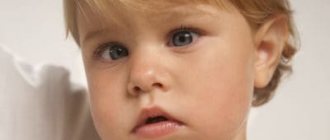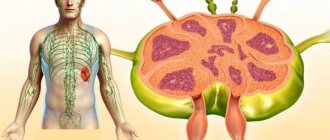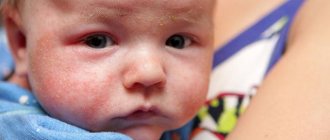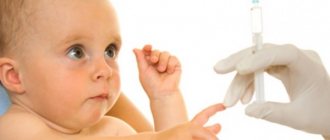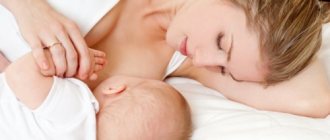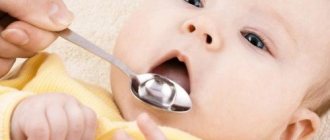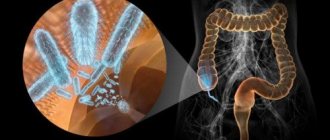Mechanism of spasm of accommodation
When stationary, the ciliary muscle is relaxed, but when the child tries to focus his gaze, it tenses and the contraction of the ligaments decreases. As a result, the curvature of the lens is transformed depending on the distance of the object in question, and the eye clearly sees the picture.
During a spasm, the “algorithm” goes astray; the ciliary muscle is in a state of prolonged contraction for a long time, which provokes deterioration of vision.
| If the spasm is not treated, then it gradually transforms from imaginary to true myopia! |
Treatment result
For the treatment of many eye diseases, hardware methods are the only solution that allows you to restore and improve your child’s vision, allowing you to avoid or delay surgical intervention. Don't expect instant results. It must be remembered that a child’s vision is formed before the age of 18, so you need to work on improving and maintaining vision all this time. For each small patient, our ophthalmologists plan regular visits for examinations and courses of hardware treatment, monitor the effectiveness of this treatment and its dynamics after each block of classes for many years.
Causes
The main reason for the development of pathology is constant eye strain. They get tired from spending a long time at the computer or in front of the TV. A thirst for knowledge is good, but sitting for hours in front of a book is bad. Spasm of accommodation most often develops for the following reasons:
- Children's furniture does not correspond to the anthropometric data of the schoolchild;
- Poor lighting in the work area;
- Decreased muscle tone in the back and neck;
- Sleep disturbances;
- Unbalanced diet, “snack on the run”, vitamin deficiency;
- Lack of oxygen, few walks in the fresh air;
- Low physical activity;
- Weak immune system.
Other factors can also provoke the disease, for example, hormonal imbalance, osteochondrosis, or a head injury. Before starting therapy, it is important to identify the cause of the disease.
Classification of spasm of accommodation
There are several types of pathology:
- Physiological. One of the most common types, manifests itself in young children. The main causes of spasm are improper treatment of eye diseases and the use of medications that are not suitable for children. The disease can be caused by a violation of basic rules of personal hygiene, which parents of infants often encounter;
- Artificial. Develops as a result of excessive use of certain medications. Symptoms appear after completing the medication;
- Pathological. The most dangerous type of spasm of accommodation, since it has a progressive form. In the absence of timely and correct treatment, it leads to serious complications.
| Most often, ophthalmologists are faced with a mixed type, combining signs of physiological and pathological types of the disease. |
Symptoms of the disease
False myopia is most often diagnosed in children. It is estimated that every 6 schoolchildren aged 10 to 17 years suffers from false myopia to one degree or another. At school age, a child’s eyes are exposed to enormous daily strain for many hours. The disease develops in schoolchildren who pore over textbooks from morning to evening in an incorrect position and in poor lighting.
Spasm of accommodation is accompanied by the following symptoms:
headache;- pain in the eyeballs;
- rapid eye fatigue;
- splitting of objects;
- inability to concentrate;
- trembling of the eyelids;
- lacrimation.
Typically, false myopia in children manifests itself in the same way as in adults. However, it is precisely in schoolchildren that this pathology most likely develops into true myopia. A spasm of accommodation during the school period, in the absence of treatment measures, leads to myopia within a few months.
Symptoms of spasm of accommodation
The main manifestations of the disease are considered to be:
- It is difficult to see objects in the distance. It is impossible to focus the gaze, the image is blurry and has an unclear outline;
- Pain and discomfort;
- Increased lacrimation and redness of the mucous membrane;
- When trying to examine an object close up, the eyes quickly become tired, burning and dryness appear;
- Poor health, loss of strength, constant headaches;
- Sometimes there is a slight trembling in the hands, a drop in blood pressure.
If a spasm occurs in children who do not yet know how to speak and cannot convey their feelings to their parents, it is important that adults promptly consider symptoms such as:
- Asymmetry of nasolabial folds;
- Trying to see an object from a distance, the toddler squints his eyes;
- Increased lacrimation and redness of the mucous membrane;
- The baby constantly scratches his eyes and blinks frequently.
To prevent the development of the disease and its transition to a real refractive error, you must immediately visit an ophthalmologist if at least one or two symptoms are detected.
Complications
If you postpone a visit to the doctor indefinitely, you may encounter complications such as vegetative-vascular dystonia, depression, tremors of the hands and fingers. Also, lack of therapy leads to the development of myopia. In addition, there is a high risk of asthenopathy – chronic eye fatigue.
Another complication that you may encounter is accommodation paresis. The main symptom of this disease is the inability to see small objects located even at a short distance. In rare cases, cataracts or glaucoma develop.
Diagnostic features
At the slightest suspicion of a spasm of accommodation in children, immediately go to an appointment with an ophthalmologist. He will conduct a visual inspection and listen to the child’s complaints. In addition, a number of diagnostic procedures are prescribed:
- Eyesight check;
- Ophthalmoscopy;
- Study of the pupil's ability to refract light;
- Determination of refraction to identify the remaining “reserve” of accommodation.
| With timely diagnosis, fighting the disease takes from several weeks to one month. |
In some cases, additional consultation with a specialist doctor (neurologist, traumatologist) is required. This is necessary to accurately identify the cause of the spasm.
Return to contents
Diagnostics
When making a diagnosis, the ophthalmologist , first of all, takes into account the patient’s complaints and the totality of clinical manifestations of the disease.
This is followed by a visual examination, during which the doctor determines the presence of visual signs, such as squinting, frequent blinking.
In addition, the following diagnostic measures :
- viziometry (visual acuity test);
- fundus examination;
- determination of refraction, assessment of accommodation reserves (the ability to focus vision on objects of varying distances);
- skiascopy.
In some cases, the patient may need to consult other specialists (pediatrician, ENT, endocrinologist). This is necessary to establish the exact cause of the disease.
Treatment options
The main purpose of therapy is to eliminate the causes of the disease and its unpleasant symptoms. Strengthening the tone of the ciliary muscle is required, and the doctor also monitors the condition of the retina. There are many methods to get rid of the disease. Only an ophthalmologist can choose the right therapy (one or more).
Pharmacy drugs
The following medications will help eliminate the symptoms of spasm of accommodation of the eyes in children:
- Irifrin. Promotes expansion of the ciliary muscle and prevents the progression of the disease;
- Mydriacyl. Helps relieve irritation, relaxes tense ligaments;
- Lutein. The active components of the drug have a direct effect on the damaged muscle and relieve tension. Can only be used by children over twelve years of age;
- Tropicamide. Allowed for use from 12 years of age;
- Cyclomed. Relieves itching, burning and stinging in the eyes;
- Atropine. Used to eliminate irritation, can be used to prevent the development of spasms.
All of the medications listed above help relax the ciliary muscle. Duration of therapy is from two to three weeks. However, treatment must be comprehensive, otherwise the symptoms will return again.
Hardware treatment
Procedures such as:
- Laser therapy. Use only for serious complications. The laser beam has a direct effect on the eye, thereby stopping the development of pathology and improving vision;
- Magnetotherapy. One of the most effective and reliable methods. A unique magnet with an alternating field is used, it affects the eyeball. Stops the progression of the disease and restores visual acuity;
- Electrophoresis. The technique is based on the instant “delivery” of medications to the posterior pole of the eye. Thus, medicinal drugs are used, but in smaller dosages;
- Acupuncture. The use of a special type of acupuncture helps restore visual function by stimulating the ciliary muscle.
| All procedures must be carried out in a clinic under the supervision of a specialist! |
Sidorenko glasses
Can be used from the age of three. Unlike medications, they have no side effects. The device helps improve hemodynamics in tissues. The glasses emit a pulse of light that helps relieve tension from the clogged muscle.
It is important that they fit tightly over the eyes, since the essence of their work is to create a low-pressure vacuum. The device is highly effective, the effect is visible after the first use. There are contraindications for use:
- Failure of the hormonal system;
- Retinal detachment;
- Bleeding in the eye.
In addition, you can use a unique ultrasound device designed to combat this pathology. This is an effective and safe method.
Exercises
They help not only eliminate the symptoms of spasm of accommodation, but also strengthen the general condition of the body. They need to be performed daily to speed up the recovery process. Make sure your child does all the exercises correctly.
- Close your eyes for fifteen seconds, open them. Repeat ten times;
- Rotate your pupils clockwise six times, then perform the same number of approaches against the movements of the arrows on the dial;
- Take turns fixing your gaze on close and distant objects;
- Draw a figure eight with your eyes. Repeat five times in each direction;
- Blink quickly for twenty seconds, then close your eyes and massage your eyelids;
- Follow your index finger, gradually moving it away and bringing it closer.
At the end of the exercises, you need to close your eyes with your palms and sit quietly for five minutes.
Massage
One of the main causes of spasm is weak muscle tone in the back and neck. To eliminate the symptoms of the disease, it is necessary to strengthen them. Massage, which is carried out in strict sequence, will help with this. It is advisable to have the first session performed by a professional.
At the beginning of the procedure, light stroking movements are performed, then the skin is vigorously kneaded to warm up the muscles and prepare them for the upcoming manipulations. Next, the skin is thoroughly kneaded to increase tone and strengthen.
The massage ends with gentle stroking. Before the procedure, apply a special cream or gel to your hands. Otherwise, there is a high risk of injuring delicate baby skin. Return to contents
Folk remedies
“Grandma’s First Aid Kit” contains many effective ways to get rid of accommodation spasms. When choosing a recipe, take into account the personal characteristics of the child’s body and the cause of the pathology.
| If the disease is caused by improper use of medications, do not experiment with traditional medicine under any circumstances! |
“Grandma’s recipes” will be an excellent addition to the therapeutic course and will speed up the healing process:
- Take 1 tsp. dried cornflower flowers and pour a glass of boiling water. Leave for fifteen minutes, strain. Give your child ½ glass in the morning and evening;
- Wash the crayfish shells, boil and finely chop. Mix the preparation with carrot juice and butter. Give children 1 tsp three times a day;
- Regular consumption of fresh blueberries has a beneficial effect on visual acuity and eye health. You can also use compote or jam from medicinal berries;
- 3 tbsp. combine rowan berries with 1 tbsp. finely chopped nettle. 4 tbsp Pour a glass of boiling water over the prepared mixture. Let the product brew for two hours, strain. Give a few teaspoons three times a day;
- Carrots and their juice contain a huge amount of vitamins and nutrients. Therefore, they must be present in the diet of children.
Treatment
Treatment of spasm of accommodation is always a set of measures. It is impossible to cure this disease with medication or exercise alone.
The complex includes:
- Drug therapy. The doctor prescribes eye drops to relax the ciliary muscle and dilate the pupil, and vitamins in the form of drops are also prescribed according to indications. Usually, for false myopia, Tropicamide, Irifrin, Midriacil are prescribed.
- Exercises. A set of eye exercises is designed to relax the eye apparatus and gradually relieve spasm of the ciliary muscle.
- Physiotherapy. This hardware method is widely used in the complex treatment of accommodation spasm. Laser therapy is recognized as the most effective physiotherapeutic method for treating this disease.
- Massage. The patient is prescribed a massage of the back and collar area to stimulate blood circulation.
- Physical education. It is recommended to include sports in your life to maintain overall body tone and improve blood circulation throughout the body.
- Nutrition. You should eat more foods containing beta-carotene and vitamin C. These include: carrots, dried apricots, persimmons, currants, citrus fruits.
- Vitamins. Balanced vitamin and mineral complexes for the eyes help strengthen vision and speed up the healing process.
The duration of treatment is individual. It depends on the age, type of activity of the patient, duration of the spasm of accommodation and the presence of concomitant pathologies.
What does Dr. Komarovsky advise?
The favorite of all mothers, pediatrician Komarovsky, devoted many of his speeches to spasm of accommodation. He is sure that great attention must be paid to preventive measures. During treatment, it is important not only to choose the right medications, but also to reduce eye strain.
The table at which the first grader does his homework must have sufficient lighting. Parents are obliged to control not only their children’s diet, but also their physical activity, and take care of a comfortable workplace. The distance from the eyes to the surface should not exceed thirty centimeters. If you do not follow the basic rules, the disease will return.
Indications for hardware vision treatment in children
Hardware treatment is indicated for patients with:
- vascular pathologies of the retina;
- myopia, farsightedness, astigmatism;
- pathological conditions of the cornea;
- strabismus;
- disorders of binocular vision;
- spasm of accommodation;
- amblyopia;
- chronic eye fatigue;
- asthenopia.
In addition, it allows you to improve the trophism of the tissue structures of the eyeball during hypoxia of the retina and optic nerves.
Hardware techniques are based on various types of physical influences.
What should you not do?
The pathology is well treated, but only if therapy is started in a timely manner. When diagnosing a spasm of accommodation, it is not recommended to:
- Choose your own medications;
- Use only traditional medicine recipes;
- Spend most of the day in a stuffy room without fresh air;
- Eating unhealthy foods;
- Delay a visit to the ophthalmologist;
- Do not follow the therapy prescribed by the doctor;
- Neglect proper lighting when your child reads books;
- Avoid overstraining the visual organ.
| Under no circumstances should you neglect the signs of the disease! If you suspect a spasm, contact your doctor immediately. |
During treatment, minimize (or better yet, avoid) computer and television viewing.
Prevention measures
Spasm of accommodation is quite easy to treat, provided that the course of therapy was prescribed correctly and the patient complies with all the doctor’s instructions. But it is also worth noting that false myopia can be prevented. After all, it is much easier to prevent the development of a particular disease than to cure it. Therefore, it is necessary to take preventive measures from a child’s early age. This will avoid not only long-term and rather costly treatment, but also unnecessary worries for parents who are worried about their son or daughter.
Prevention of false myopia
The main preventive measures to prevent the development of false myopia include:
- reducing the load on the visual organs . Make sure your child takes regular breaks when reading a book or working on the computer. Try to keep him busy with something else, more interesting and exciting, to thereby limit the strain on his eyes;
- take care to ensure good lighting in the child’s room and his desk (where the child writes and does homework);
- the distance to the TV, books or computer monitor should be appropriate , that is, comply with the recommendations of doctors;
Optimal distance from eyes to monitor
- teach your child to do regular short warm-ups during work . This will avoid eye fatigue and also preserve visual acuity;
- in a sitting position he should always keep his back straight . For this purpose, purchase a chair or chair with a back that will suit the child in size;
- It is useful for a child to spend a lot of time outside , playing active sports (football, jogging, cycling);
- watch your diet . The child should consume a sufficient amount of healthy food daily, containing various vitamins and minerals.
Child nutrition
Compliance with these preventive measures will not only prevent the development of pathology, but also tone the body. Even if your child has been diagnosed with a spasm of accommodation, there is no need to immediately panic. The disease is curable. You just need to approach solving this problem with all seriousness, and in no case ignore the symptoms that appear. Thanks to the different types of therapy methods that modern medicine offers, the doctor will be able to choose the most suitable one for your child, which will really suit and help him.
Preventive measures
To prevent the development of the “tired eyes” symptom, follow simple rules that will protect against muscle spasms and improve your child’s health:
- Alternating load and rest. When doing homework and while reading books, take short breaks for gymnastics;
- Take care of the lighting of the student’s workplace;
- Watch a first grader sit at the table. He must monitor his posture and body position;
- Walk more often, play active games with your baby;
- Parents should take care of strengthening the child’s immune system and monitor his health.
Buy special glasses for watching TV and working at the computer; they reduce the harmful effects of prolonged exposure to the screen.



